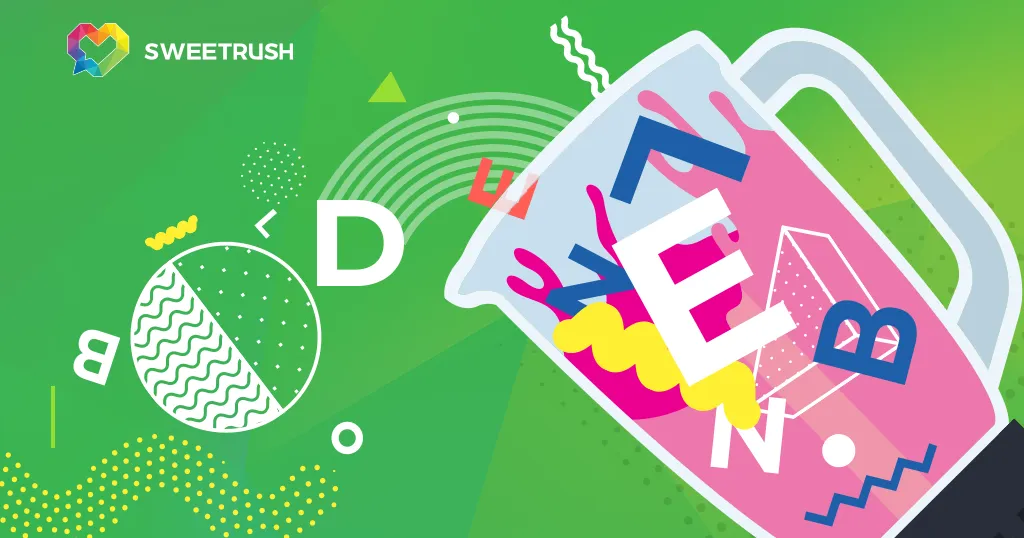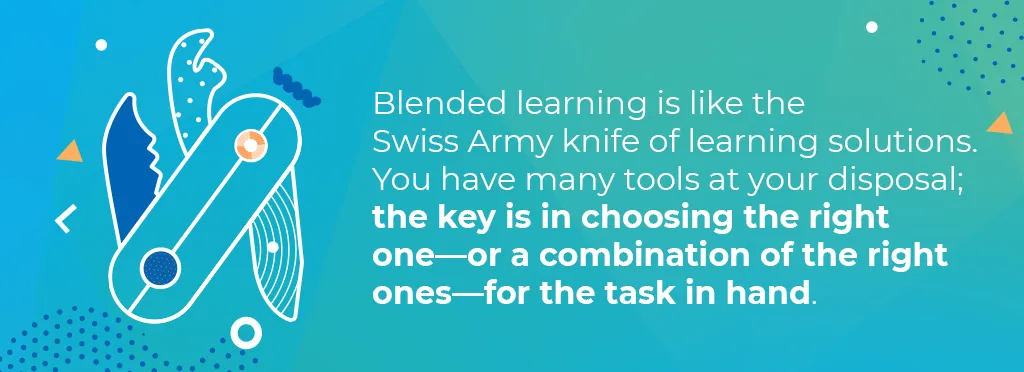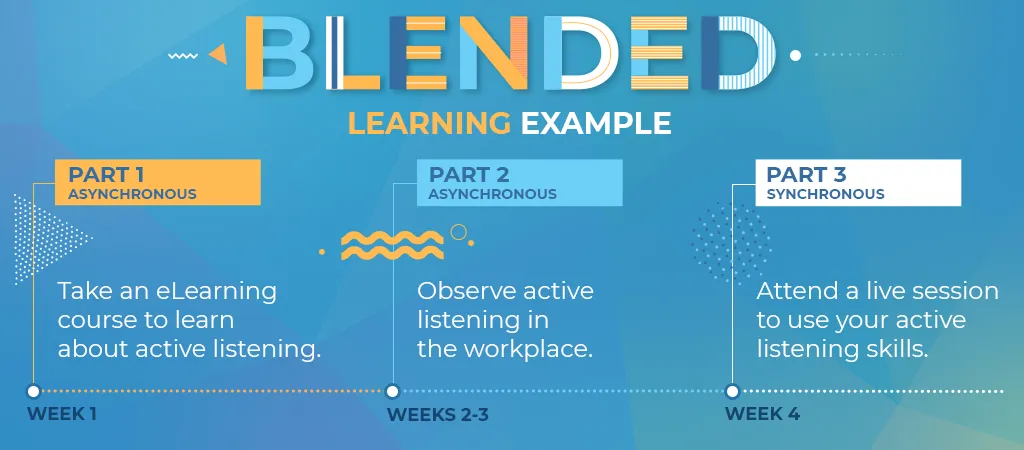
Blended learning is a great option for knowledge- and skills-based content and outcomes, as it lets you leverage the best and most cost-effective tools for the job.
Blended learning describes learning solutions that combine two or more learning modalities. The blend could include asynchronous training modalities—such as eLearning, reading, research, and observation—or synchronous modalities, such as instructor-led or virtual instructor-led facilitation or a mix of both.

Blended learning is like the Swiss Army knife of learning solutions. You have many tools at your disposal; the key is in choosing the right one—or a combination of the right ones—for the task in hand. And blended learning is also a great “best of all worlds” solution to consider when your learning includes both knowledge-based and skills-based content and outcomes, as it allows you to leverage the best and most cost-effective tools (modalities) for the job.
Let’s take soft skills training, and use a very typical example. For many years, we believed the only way to teach soft skills effectively was in a classroom setting with a skilled facilitator. The training would typically begin with icebreakers and introductions, and then the facilitator would explain why this particular soft skill is important by sharing some examples. She might then go on to discuss the science, history, or theory behind the various models and tools—before revealing them and explaining how to use them. Afterward, she might demonstrate or show more examples of using video or case studies. At the end of the day, learners would finally get a chance to practice applying their new skills. More often than not, however, there wouldn’t always be enough time left for this, which inevitably meant that not everyone would get the chance to have a go.

Setting aside the financial side of things, the cost to learners of attending a program like this was extraordinarily high because they had invested more of their time listening to or observing the facilitator rather than actually practicing their new skills.
Blended learning solutions can help to address this imbalance by taking content that doesn’t require a facilitator outside the classroom and reserving the classroom time for meaningful practice, coaching, and feedback.
As with all learning solutions, it’s critical that your learning objectives and expected outcomes have been clearly defined before embarking on any blended learning solution development. This includes defining not only the overall program objectives (i.e., what will learners know and be able to do at the end of the program) but also at each step along the way.With that in mind, here are our top three tips for creating a blended learning solution:1. Look at the content and decide which pieces can be studied asynchronously and synchronously, and then select the most appropriate modality for each.
[table id=1 /]2. Consider the best way to chunk out and sequence your learning.
3. Balance the time between asynchronous and synchronous activities carefully. If too much time passes between tasks performed outside the classroom and the actual classroom sessions, there’s a risk that learners may forget what they’ve learned. Conversely, if tasks or sessions are grouped too close together, learners may not have time to fully review or synthesize the content. Consider your audience and their capabilities and the content and its complexity to help gauge the timing between activities.
Here’s what our new blended soft skills learning solution might look like:

Part 1: Asynchronous learning activities – Take an eLearning course to learn about active listening.
Part 2: Asynchronous learning activities – Observe active listening in the workplace.
Carry this out on an ongoing basis between completing your eLearning and attending class.Part 3: Synchronous learning activities – Attend a live session to use your active listening skills.
Attend this class two to four weeks after the eLearning is complete.In this solution, we’ve extracted the knowledge-based content and designed it as asynchronous activities (eLearning and observation), and we’ve reduced the classroom time by using it to focus solely on the practice and application of skills-based content. (This particular approach of delivering theory first and then gathering to practice is also known as “flipping the classroom.”) We’ve also recommended leaving no more than four weeks between eLearning and the classroom activity, and suggest some on-the-job observation and tasks in between to help maximize retention.
Now that you have some of the basics, here are more things to think about when putting together your own blended learning solutions...Know your audience. Understanding who your audience is and what their preferences are will help to ensure the success of your blended learning solution—particularly when selecting modalities. Things to think about include but are not limited to:
Set expectations at the beginning of the blended learning journey:
Consider forming cohorts. If your blended learning solution comprises multiple components or sessions or will span a number of weeks or months, think about creating cohorts to help foster inclusion, teamwork, and collaboration. Adding a social component—such as Skype or WhatsApp chat groups—will provide teams with access to support and encouragement from facilitators and each other throughout the experience.Administration: While blended learning solutions can often ease the burden of facilitation of more traditional in-person, synchronous training events—such as instructor-led training (ILT) or virtual instructor-led training (vILT) programs—they can come with an added administrative strain. This is particularly true when programs span several weeks or months or contain multiple offline or online activities—not to mention multiple participants. We have listed some of these administrative tasks here:
Last but not least, here are some other factors that can contribute to or get in the way of the success of blended learning solutions:
Do you have a project in mind and think we can help? We’re happy to discuss how to best design and deliver your blended learning program for maximum impact, retention, and skill-building. Give us a shout!